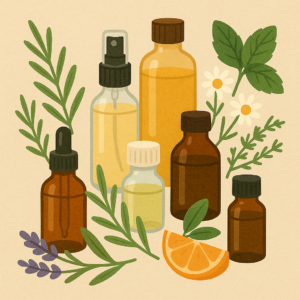
Essential Oils for Children: What’s Safe and What’s Not
Essential oils are powerful tools in holistic wellness, offering natural support for everything from sleep and focus to immunity and emotional balance. But when it comes to children, extra care and caution are essential. Their smaller bodies, developing systems, and sensitive skin mean not all oils—or methods of use—are safe. Here’s what every parent or caregiver needs to know about using essential oils for children safely.
🌿 Why Use Essential Oils for Children?
Many parents are drawn to essential oils as a gentle, natural way to:
-
Ease colds and congestion
-
Promote restful sleep
-
Calm anxiety or tantrums
-
Support focus and attention
-
Boost the immune system
However, using essential oils safely for little ones requires knowledge, proper dilution, and age-appropriate choices.
✅ Kid-Safe Essential Oils
These oils are generally considered safe when properly diluted and used appropriately for children over 6 months to 2 years (depending on the oil and application):
-
Lavender (Lavandula angustifolia) – Calming, helps with sleep and anxiety.
-
Roman Chamomile (Chamaemelum nobile) – Soothes crankiness, great for teething and sleep.
-
Sweet Orange (Citrus sinensis) – Uplifting and calming.
-
Frankincense (Boswellia carterii) – Supports immune system and emotional grounding.
-
Cedarwood (Cedrus atlantica) – Promotes calm and restful sleep.
-
Tea Tree (Melaleuca alternifolia) – Antimicrobial (use with caution and proper dilution).
🔍 Always choose high-quality, pure essential oils from reputable sources. Look for oils labeled safe for kids.
❌ Essential Oils to Avoid for Children
Some essential oils are too strong, potentially irritating, or even toxic for children. Avoid using the following on or around young children:
-
Peppermint (especially under age 6) – Can slow breathing.
-
Eucalyptus (E. globulus or E. radiata) – Risk of respiratory distress in young children.
-
Wintergreen – Contains methyl salicylate, similar to aspirin—can be toxic.
-
Clove – Potential skin irritant and too strong for children.
-
Cinnamon bark – Hot oil that can cause burns or irritation.
-
Thyme and Oregano – Potent oils that can be overwhelming or irritating.
📏 Dilution Guidelines by Age
Always dilute essential oils with a carrier oil such as coconut, jojoba, or sweet almond oil.
-
0–6 months: Avoid essential oils unless under professional guidance.
-
6 months–2 years: 0.25–0.5% dilution (1 drop per 4 tsp carrier oil)
-
2–6 years: 1% dilution (1 drop per tsp)
-
6–12 years: 1.5–2% dilution
👶 Tip: Diffusion is often a safer method for young children than topical application.
💡 Safe Ways to Use Essential Oils with Children
-
Diffusing (15–30 mins) in a well-ventilated area
-
Roll-on blends (properly diluted)
-
Bath time blends with a carrier or dispersant
-
Aromatherapy inhalers (for kids over 6)
-
Linen or room sprays (mild and diluted)
🛑 Safety Reminders
-
Do a patch test before applying any oil topically.
-
Keep oils out of reach—some are toxic if ingested.
-
Avoid applying near eyes, nose, or genitals.
-
Never use undiluted oils on children.
-
If your child has asthma, allergies, or other medical conditions, consult a pediatrician or certified aromatherapist first.
🌈 Final Thoughts
Essential oils can be a beautiful part of your child’s wellness journey when used with care, respect, and proper knowledge. Always start slow, observe how your child reacts, and trust your intuition as a caregiver. When in doubt, consult a certified aromatherapist who specializes in children’s wellness.